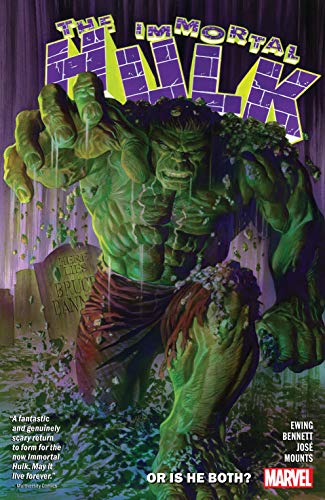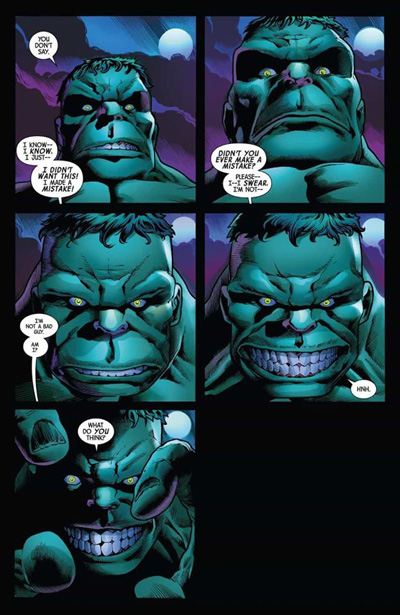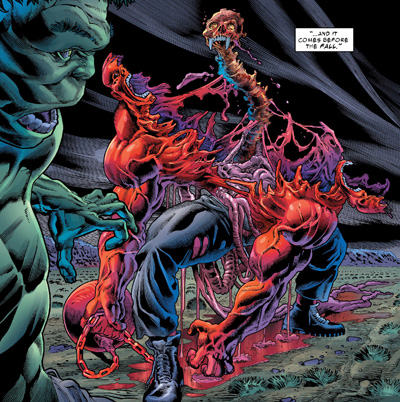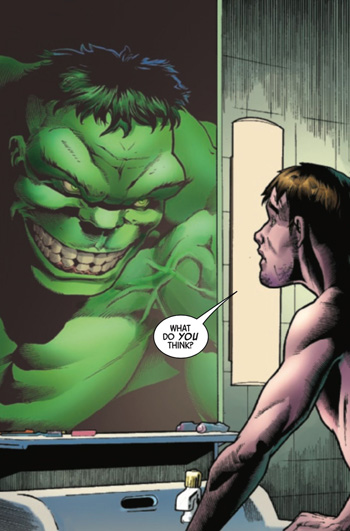Hulk as Horror
I know this title is still ongoing, at least for a few more months, and I’ve never had an opportunity to review the individual issues — but again, I live four hours away from the nearest decent comics shop, so I’ve had to make do with trades for a while. Nevertheless, let’s review this as a whole production. It’s time to look at The Immortal Hulk, written by Al Ewing and illustrated by Joe Bennett, with cover art by Alex Ross.

When the Hulk was created by Stan Lee and Jack Kirby in 1962, the character was as far as possible from the stereotypical lantern-jawed titan of justice. Stan Lee was inspired by a number of characters when creating him, including Frankenstein’s Monster and Dr. Jekyll and Mr. Hyde.
And the early Hulk showed those influences very strongly. The Hulk was a misshapen brute who could only take his powered form at night. The earliest Hulk was not a “HULK SMASH PUNY HUMANS” dimwit, but he didn’t have the refined intellect of Bruce Banner. He was cunning. He was, frankly, a raging asshole. And he could occasionally shapeshift in strange and unplanned ways.
Of course, time marched on, and it wasn’t long before we had the familiar Hulk we all know — not smart, incredibly angry, often heroic, but not always. But he’s a star. He’s been on TV, he’s been in cartoons, he’s been in movies. He’s safe, snuggly, loveable, at least to his mass media fans.
At some point in the comics, he’d gotten killed — the archer Hawkeye managed to kill Bruce Banner when he was temporarily cured of being the Hulk — but comics being comics, this didn’t last long, and the nature of Hulk’s resurrections had some wondering if he was actually immortal.
So when Al Ewing and Joe Bennett took the series over, they decided to take the Hulk back to his origins. They restored his cunning, merciless personality. They restored part of his original look.
And here’s how Issue #1 went. Bruce Banner is traveling again, staying undercover, and staying out of trouble. He stops in a convenience store at the same time as a kid with a gun decides to rob the place. He flies into a panic and starts spraying lead. The clerk catches a bullet. A bystander catches a bullet. Banner catches a bullet. All of them die.
Until nightfall. The night is when the Hulk rises from the dead. He’s smart. He’s cunning. And he’s angry. Coldly, terribly angry.
He finds the gang who ordered the kid to make the robbery. He takes them out. And the last one, the shooter, insists he only made a mistake, he’s not a bad guy.
And the Hulk smiles.

“The Immortal Hulk” isn’t a superhero comic. It’s a horror comic.
Who is this Hulk? Aside from his devious intelligence and icy rage, he’s much more controlled than most of his personas. He can converse civilly with anyone he wants, and he knows how to make intricate plans to get what he wants. And he still wants justice for the world — however, his plan to get justice involves, well, destroying the world. And Bruce Banner is, for once, in agreement with him.
The Hulk looks very much like the classic Hulk. No non-green colors, no mobster suits, nothing out of the ordinary, at least as far as gigantic green lumps of muscle and malice go. He’s got the giant Neandertal-esque browline, he’s got the snub nose, he’s got the oversized upper lip, the flat teeth, the beady eyes — but the eyes are greener than normal, and there’s plenty of white around the iris. They are eyes that say someone very smart, not very sane, and very, very scary is living inside that skull, and anyone who finds themselves eye-to-eye with that face is likely terrified out of their wits — and this definitely includes the reader.
In subsequent issues, the Hulk destroys a scientist who experimented on his own son using gamma radiation to make him immortal, he gets a hole blown clear through his chest, he tangles with Walter Langowski, the Sasquatch from Alpha Flight, who’s become possessed by an undead spirit who might be either Bruce Banner’s father or the One Below All — the Devil itself — or maybe even both at the same time. He gets carved into chunks and stored — alive and aware — in big glass jars. He gets dragged down to Hell, where he spends a whole storyarc horribly emaciated. He gets his face torn off more than once, always in loving closeups. He gets overdosed on gamma radiation and turns into a tumor of Hulks. We even visit the end of time when the Hulk is the last being alive, monstrously powerful, controlled by the One Below All, a cosmic horror smashing his way through one universe after another.
And over all of this rises the mystery of the Green Door, a magical gateway every gamma mutate sees when they die. What is its purpose? How does it work? Who controls it?

And it turns out almost anyone with powers based on gamma radiation is going through their own terrible, horrific mutation. The Absorbing Man, who can drain gamma radiation, ends up with his body split open and his skull and spine waving in the air like a serpent when he absorbs too much. Betty Ross regains the ability to turn into the Harpy, but a far more powerful, horrific version, willing and eager to kill and eat anyone who gets in her way — including the Hulk himself. And the Abomination becomes an even more dreadful monster, an acid-spitting horror with a maddening, indescribable anatomy. Rick Jones is missing, presumed dead, for quite a while before he eventually shows up and starts making his own disturbing transformations. And the Leader? No one really knows where the Leader is…
And yes, there’s horror and body horror and battles against characters who should be familiar but have become bizarre and creeptastic, but we should also acknowledge that the character work here is thoroughly excellent. It’s not just that the gamma mutates change their personalities every time they shift shape, but the other supporting characters are all well-done, too. The two most important in this series are Jackie McGee — not the antagonistic reporter from the ’70s TV show, but an African-American reporter for the Arizona Herald, who’s following the Hulk to write articles about him — and General Reginald Fortean, the commander of Shadow Base, a secret anti-Hulk military project.
Verdict: Thumbs up. The key question is this: Is the series worth reading? And the answer is: You’re damn straight it’s worth reading. It’s great to see long-form horror starring familiar superhero characters, particularly Marvel’s original Silver Age horror character. Al Ewing’s writing, stories, and dialogue are all excellent, and Joe Bennett’s art is downright revelatory. His characters are wonderfully expressive, showing every moment of fear and pain, as well as layer upon layer of rage — and the horrors he shows off are, even for those of us protected by the impenetrable barrier of the comics page, surprisingly and sometimes gut-clenchingly terrifying.
The series won’t last forever — it’s probably got about a dozen issues to go, at this writing, before it reaches Issue #50, when Ewing plans the end. But there are plenty of collected editions you can pick up right now.

Is it worth reading? If you love the Hulk, if you love horror, if you love great comics, it’s not just worth reading, it’s required reading.
